Established around the late 90’s when India’s IT revolution had taken off and India became the buzzword in IT circles, this institute was meant to be a catalyser for growth in the IT industry. Looking back with satisfaction, Prof. S. Sadagopan, Director, International Institute of Information Technology Bangalore (IIIT-B), elaborates on how the institute has made distinctive strides in entrepreneurship, innovation and research. Stressing on the need for technology to cater to society, firmly based on an interdisciplinary approach even as it underscores ethics and professionalism, he enumerates the unique ways in which IIIT-B creates leaders of tomorrow for the IT industry
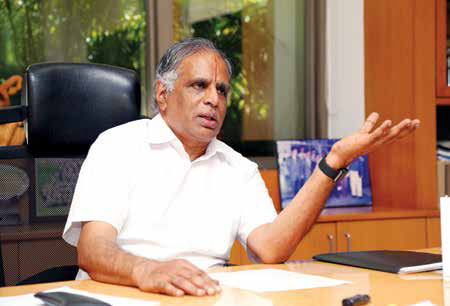
International Institute of Information Technology Bangalore (IIIT-B) was started by the Government of Karnataka (GoK) and the IT industry in 1999 and I was asked to run it. If you look back, there were a few areas in which India’s made major contributions. Globally, Indian textiles, even today, contribute some 30-40 billion dollars as export. ATIRA or Ahmedabad Textile Industry’s Research Association in Ahmedabad and another textile research institute in Coimbatore did some research which helped the textile industry grow, modernize, and adapt to the needs of the economy. Similarly, leather export is another key export contributor, in which the CLRI or Central Leather Research Institute in Chennai is supposed to have played a similar role. So, in 1997, the Karnataka government thought that Information Technology would be a big export powerhouse and that having an institute which would catalyse the growth of the IT industry would be good. Looking back, it indeed made sense.
IIIT-B was born in 1999. Those were interesting times; the world was, in some sense, changing. Y2K was the buzz, obviously the Indian IT industry came centrestage. There was also the dotcom boom and bust. That was also the time people started visualising the IT industry to be a trillion-dollar industry which it eventually became in 2009. But people could not think that IT would come close to auto and oil, the then dominant trillion-dollar industries.
It’s like this. If we look at the leather industry, the technology of leather has to do more with chemistry and there were enough chemistry departments around. But by themselves, they would not have done enough because it needed a critical concentration of chemists with a particular focus. Similarly, with engineering colleges, an institute focusing only on IT would accelerate the whole thing. They must have thought along those lines.
When I came on board, I think it really fortunate that the powers that be, both from the industry and the government, gave us complete freedom. And allowed us to shape the institute in our own way.
We visualised three things for IIIT-B: First, computing will always play a larger role than simply producing computers and doing some data processing. In retrospect, we feel that we have been vindicated. Second, we felt computer and communications together will probably create opportunities much larger than opportunities created by communications alone or computing alone. Third, entrepreneurship and startups will play a big role. If Infosys could start with limited capital simply because this industry is more brain intensive than capital-intensive, we will have great opportunities for startups. Even with the very first batch, we had a student who had a startup and never sought a job.
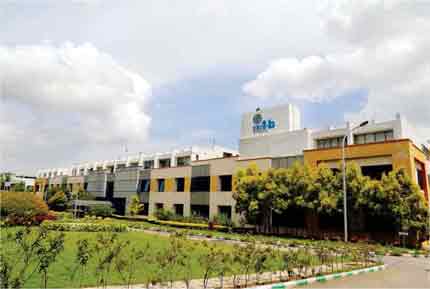
One of the things we wanted was to have a non-department structure with individual focus areas with considerable overlap something along the lines of the Olympic rings, each ring overlapping the other so that no ring is isolated. We realised that people could be interested in at least two disciplines. So we planned for 60-70 faculty members and about 700-800 students. We realised that most innovation would take place in interdisciplinary areas. That’s precisely what’s happening there’s biology and computing, GIS (geography and computing), banking and technology, automation and technology. We also realised that society would be an important part of all the innovation. Information Technology is so impactful. It impacts everyone. We realised that mobiles would play an increasing role. But who thought there would be nearly a 1:1 mobile ratio in our lifetime? We thought it could happen in 2030. But it happened in 2013 or 2014, right?
When something like that happens, it is important to be sensitive to social needs. When a tech like Aadhaar is introduced, we should not be blind to issues like privacy. At the same time, we should not get bogged down by privacy. So we said we need to create social scientists who have an appreciation for technology, who understand technology and who can allow technology to play its role. But, we generally find that many social scientists think that tech is for the big guys, for the rich, for city folks, that tech will never solve India’s problems, that India’s problems will be solved only by khadi and village industry.
There are also technologists who feel that if they can make a car that is cheap enough, they will solve the mobility problem. But that is not true. Even if petrol costs zero, even if every Indian can afford a car, we will have more misery. So, we needed to create a set of professionals who could ride two-horse carts, on one side tech, and the other, social science. We had to wait until three years ago when we started offering a programme, MSc in Digital Society.
The idea is to take 50% of engineers and 50% of social scientists, put them together, make them work for two years, understand each other, so that they have a deeper appreciation of the other’s viewpoints. Both should avoid dogma. Technilogists should not think they have solutions to all problems. Social scientists should not think technology cannot solve problems. We need a balanced approach.
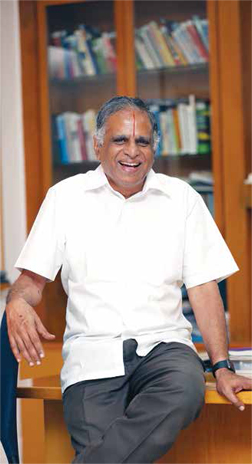
We take in sociologists, city planners for this course. We take in PhDs in Economics, people from business schools. We have one person from the media. In fact, we would be happy to have a linguist, because if the content has to be local, it has to be in the local language. Otherwise, we don’t understand the issues of the local language. Secondly, if the content is in Kannada and Tamil, we should be able to search for keywords in Kannada and Tamil. Quite often, many technologists are dismissive about such issues.
Content is one thing. But there are other problems. There are doctors who write prescriptions in English. But some patients cannot read English. It is easy for the government to say all doctors must write in Kannada. But that will not solve the problem, it is a waste of time, and doctors should actually spend more time on their patients. If there’s a simple technology that automatically translates a prescription in English into Kannada as soon as it is written, then the doctor writes it in English and the patient reads it in Kannada. Done.
So, we have communication engineers, computing engineers, social scientists and pure scientists. Pure scientists, because science is important. Maths is important. We realised we needed a full-fledged mathematician. We have been looking for a person with a background in Biology. Fairly difficult Math is routinely used in cryptography today. You must have heard of bitcoin. Some of these areas use some of the theorems by Ramanujam. This happened because people from mathematics and computer science worked together.
I also have a colleague who works in an area called visualisation. Computer visualisation came out of computer graphics. You see, it was used during election results: how BJP is performing, how Congress is performing, etc. That is visualisation.
If pure science, social science, computer science, communication science and others work together, because of their interdisciplinary nature, we will be able to create new startups.
“To me, first and foremost, a leader must inspire. Second, he must be knowledgeable. Others must feel that they actually gain knowledge from him. Third, a leader should also have empathy. I believe that in the name of leadership qualities, we create bosses. A boss isn’t a leader”
IIIT-B offers these courses:
We don’t have a departmental structure, people here work seamlessly. But people need an identity. So we have what are called domains. There are domains and there are domain coordinators. But the idea is, as much as possible, break barriers. We don’t have a departmental budget and departmental space allocation. When you have a budget, you automatically have department buildings.
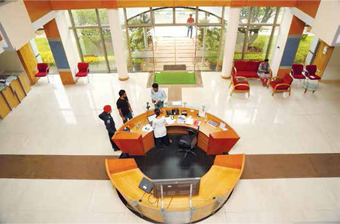 Ideal learning environment at IIIT-B, to stimulate intellectual and personal growth
Ideal learning environment at IIIT-B, to stimulate intellectual and personal growthAll the faculty share space. We have a set of rooms. The first room available is allotted to the first person available. The idea is to make people interact. I think a lot happens when people talk to each other.
Luckily, they have taken to it well. This is the advantage of being a small institute. We recruit only assistant professors. We take in youngsters. In some sense, they have no legacy. For a majority, it is their first job. We do have maybe half a dozen senior people who have decided to do different things. We have Dr Srikant who is a PhD in Computer Science from Cornell way back in the ‘80s. He spent 15 years in the US with graphics, startups and big companies. I’d say 45 of the faculty are fresh PhDs this is their first job, they also seem to enjoy it. It also helps that we are located in Bengaluru.
One of our startups is TutorVista, which essentially disrupted online remote tutoring. Just this morning, one of our startups—from one of the incubated companies from our IIIT-B startup cell— got its first order from the Indian Railways. It will use very sophisticated scheduling algorithms. The railways has a million staff, tens of thousands of drivers, tonne of locomotives. Locomotives are expensive. Each can cost several crores. Quite often, a locomotive is allotted to a driver, but there are delays or the locomotive has derailed, it needs repairs. Sometimes the driver is working for over 20 hours. Generally, people use a simplistic solution— allocate one locomotive to three drivers, and they will manage somehow. But quite often, locomotives are not well utilised. This is a big data problem, requiring much larger computing power. You can’t do it in just any computer centre. You need cloud.
Today, if a locomotive is down, the driver does not know what to do. But the startup finds solutions by working on the schedules of thousands of drivers and locomotives. In fact, these are like the problems that companies like Ola have solved. Uber can schedule hundreds of thousands of calls and hundreds of thousands of drivers. This startup claims that if we do something similar, it can save 10% of the locomotives. That is, it will save nearly 20,000 to 30,000 crore.
There’s another startup at IIIT-B called M2M, Machine to Machine. The students made a completely India-designed watch. It’s like a google watch, but with more features. It has specialised Wi-Fi. The group’s used two-use cases. One is for workers in mines. When there is an accident or a landslide, these workers cannot come out. And if the message doesn’t reach out fast enough, they perish. Instead, if given the watch, the watch will communicate with those outside. It also has a small camera which takes pictures and automatically transmits them. The second use case is an ambulance carrying a patient. Until the driver and the patient reach the hospital, the doctor usually does not know patient details. With a camera, the driver can send pictures of the patient’s condition and the doctor has much information ready beforehand.
Again, some startups succeed because of the interdisciplinary system. For example, we have an e–health research centre where we work with NIMHANS on health related areas. During our interaction, the idea that maybe we should do something about ambulances came up. So, IIIT-B’s vision is to look at IT as something larger than simple computer science courses. Look at it holistically, and look at it also to change India. At the same time, take a balanced view.
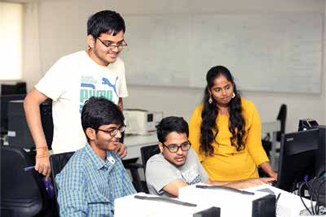 All students at IIIT-B have WiFi-enabled laptops for their exclusive use and access to a cloud-based printing service
All students at IIIT-B have WiFi-enabled laptops for their exclusive use and access to a cloud-based printing serviceAn interesting project was the one using missed calls. Missed calls are a big phenomenon, and this bright undergrad called Valerie Wagoner studying Sociology at Stanford had heard about India and its use of mobiles. Wagoner thought of looking at science and technology together. She came to Bengaluru. She studied how people in the Ejipura slum used mobile phones. Many were illiterate, what did they use them for? She had never heard of missed calls. But she discovered they used them in a big way. They said missed calls had some advantages. One, you don’t have to spend to make a missed call. There is also what is called a zero-byte message; a woman visiting another town can give a missed call back home to imply she’s reached. For Ejipura residents, within their population, a missed call is actually a message. So, Wagoner came up with an idea. Those were the days when the banking system was evolving, like core banking. She thought, if a customer’s mobile number is registered with the bank, it knows when the customer gives a missed call. If the bank assigns numbers for extra information, the customer can give a missed call and elicit information. For example, he can know the bank balance via a “missed call”, or the last 10 transactions or the cricket score. You can actually do that by using a small application. Wagoner built a small service around it. I had the privilege of being on the board of Bank of India, so I said let BOI try it. Now every bank uses it. She created a company called Zipdial. It was acquired by Twitter for about 3 million dollars. Imagine, it all began in our Ejipura slum.
But if she hadn’t been a sociology student, she wouldn’t have done it. Tech plays a role, but I don’t think anyone of us would have gone to Ejipura, or if we did, we would have seen a lot of maids using mobiles, and that would be that. But she went there, day after day, finding out what they were doing. And then realising that banking was a need. That’s where interdisciplinary social science and technology coming together helped.
 The IIIT-B Library’s ongoing mission is to deliver resources and services to
support learning, teaching and research activities
The IIIT-B Library’s ongoing mission is to deliver resources and services to
support learning, teaching and research activitiesIn my personal view, we sometimes make too much of leadership skills. Because to me, the cradle of leadership is about who really is a leader.
To me, first and foremost, a leader must inspire. Second, he must be knowledgeable. Others must feel that they actually gain knowledge from him. Third, a leader should also have empathy. I believe that in the name of leadership qualities, we create bosses. A boss isn’t a leader.
When students join the institute, we welcome them with the message, “Welcome to ‘your’ institute”. I actually write that on the board at the orientation. The very message is that you own the institute, including hostel food. For example, any hostel food becomes insipid after some time, a common complaint. Turn it into an opportunity: let the student community decide on the menu. They discovered the food was insipid because the menu was programmed, planned. So, they randomised it. Therefore, ownership helps. We also try to communicate that leaders don’t grab, they share. So, students visit slums, institutes, churches, orphanages and spend time, and listened to kids who do not have the same opportunity as us - that’s important.
Even democracy offers insights into leadership. Here, there is no separation between faculty and students and staff or the director. We use the same bathrooms, eat the same food.
In IIIT-B’s early days, my colleague and I would play a game. He would drop a piece of paper and I would pick it up. The idea is that they own the place. This is the 14th year of the institute operation in E-City and we have not painted it even once. Keeping it clean is everyone’s job.
We have maids, security guards; we make it abundantly clear to the students that they will be nice to them, they are as important citizens of the institute as we are.
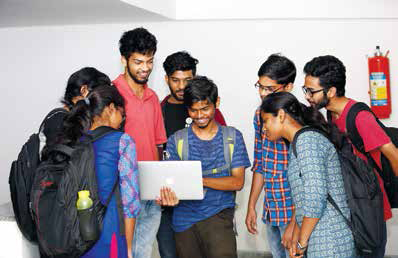 Students at IIIT-B campus
Students at IIIT-B campusWe try to create less of a competitive culture. Placement is important but when somebody gets placed, he or she does not throw a party until the last person is placed. It’s important for them to understand that your success is decided by the success of your batch. To us, this is more important than how we evaluate, how the KPI factor should be; KPI is important, but it is important to do it in a spirit of equality.
Avoid undue competition, but some amount is important. We have awards for contribution to campus community life. It is important to get the highest grade, but did you make a difference to the community?
We also have KSM – Knowledge Sharing Mechanism. In many institutes, there is this notorious term called ragging. We think, instead of harassing juniors, why don’t you help them? Not only is there no ragging, every batch feels their best friends are their seniors. To me, the definition of a leader is a person who is the last person who quietly pushes everyone forward. He is not the first person in the first row who keeps on walking and does not even look back to see whether people follow him or not. Leadership is not only about power, or netagiri. It is an opportunity to contribute. You can be the smallest person and yet be the leader.
Here’s an example. We had a security guard, ten years back. There were three girl students who would help him out with money. These girls did not get placed. You would think they would be crying, but it was the security guard who was crying. Because they give him respect, he treated them like his daughters. Ten years after they graduated, the students still send him money. We keep telling our students—he could be more intelligent than us. Only, he had no opportunity or resources.
“Information Technology is so impactful. It impacts everyone. We realised that mobiles would play an increasing role. But who thought there would be nearly a 1:1 mobile ratio in our lifetime? We thought it could happen in 2030. But it happened in 2013 or 2014, right?”
In learning, there must be individual learning. If you are always a sleeping partner, you won’t learn anything. I’d say 30-40% is about individual learning. So, every course has multiple-group projects. We also have larger group projects outside the course—a newsletter, events, compering, or management. Even budgeting. For sports day, students do everything—budgeting, planning, guest management, etc.
The advantage is we get students from all over India. We suggest that students don’t form groups by region. Some come from the same B. Tech college and they hang out together. We try to mix them.
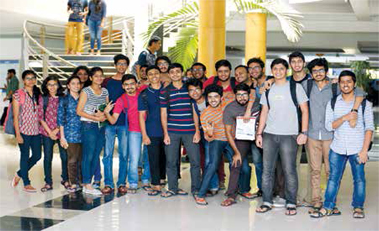 Students at IIIT-B campus
Students at IIIT-B campusWe have a multiple dimensional course, which includes ethics. When you work in groups, you must ensure ethics; else, how do you ensure that everyone gets equal credit? Or if someone has done more, how does he rightly get proportionately large credit?
Take plagiarism. How do you take care of that? With a course called professionalism. So, ethics is important. These days there’s another interesting dimension—local and global. Let’s say you work for Intel. Intel is an American company. Obviously, when it comes to certain things, the Intel management would take into consideration the larger American interests than Indian interests. But how can you be sensitive to some of these nuances? Similarly, when you work for the Tatas, do you always take the Indian position? Because Tata’s TCS is not just an Indian company. It probably gets more money from the USA.
Another example is a student’s project, based on a glove. In some cases of acute arthritis, the doctor prescribes physiotherapy—a nurse holds your hand and moves it in certain ways some 300 times. But if you don’t get nurses or can’t afford them, you wear this glove and the glove does the nurse’s work. We are working with NIMHANS, getting a patent for it. When you work with doctors, they bring certain skills, certain strengths. You also bring certain skills, certain strengths. You need to know how to respect each other. If the doctor is not involved, you don’t get credit. But he can’t take all the credit either. Across disciplines, how do you ensure that? That’s part of professionalism.
Consider the issue of privacy. The glove project collects information about the patient and feeds it into the glove. Or let’s say you take a CT scan at a diagnostic centre. The diagnostic centre won’t tell you what it does with the information. Similarly, you go to a doctor, the doctor gathers information about you and files it. Technically speaking, you own the information. But how do you ensure that the diagnostic centre which has a Phillips machine does not send it to the Netherlands?
To me, a simple CAT scan is an imaging device; to a doctor, it is a tool; to a patient, doctor and hospital put together, it is a healthcare aid. Similarly, a bank manager knows about his bank accounts. Technically, should he have access to our information? We still have not answered such questions. It will take a while. I think this is where a technology person and a sociology person must come together, and we will have a balanced view, not an extreme view. This is what is broadly covered in the course on professionalism.
In technology, India is doing much better than many countries in the area of diversity; 30-40% students in most engineering colleges are women.
But it is not reflected in leadership positions. It’s not bad, we are actually better than many countries. But many places in India are not friendly to working women. You don’t have a crèche, you don’t have baby care. We are lucky because we have imbibed a different set of values since we were born in 1999. But even in some premier institutes, women don’t even have easy access to toilets on all parts of the campus. Is it because there are not enough female staff around? No, it is a thought process. But things are changing.
IIIT-B is one of the best in diversity among faculty members. Almost 30% are women. One has to make things welcome, easy for women. When female faculty here find it a women-friendly place, they spread the word. That has helped.
We also have a far more flexible timings. Most male faculty come at 8:30 am and leave by 4:30 to 5 pm. But a few men and women work from 11 am to 7 pm. Some female faculty with little children work from 7:30 am to 2:30 pm. Some work from 10:30 am to 4:30 pm and then work from home.
By Geetha Rao